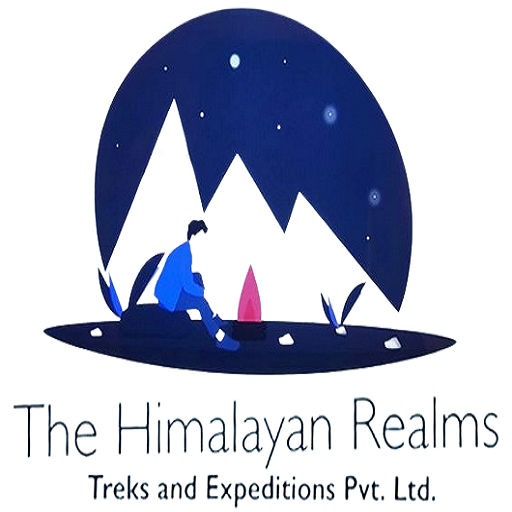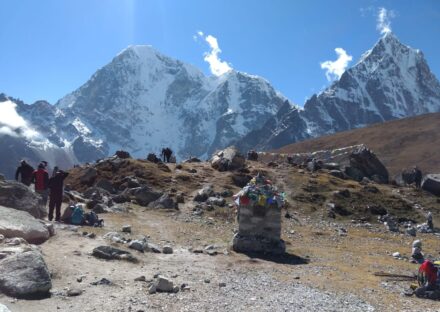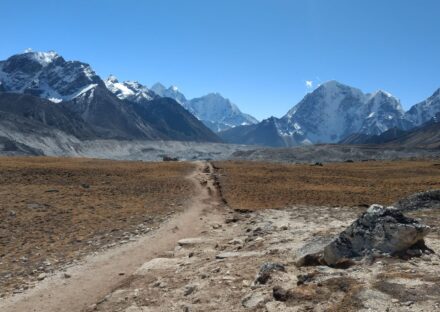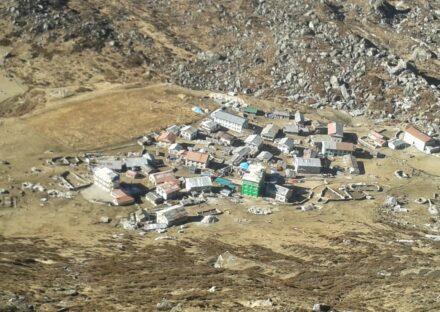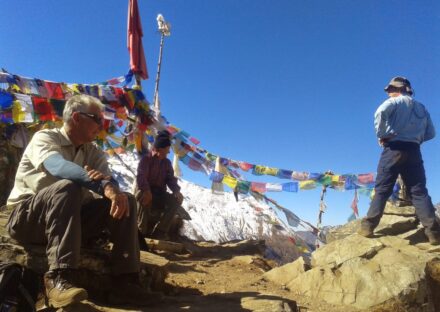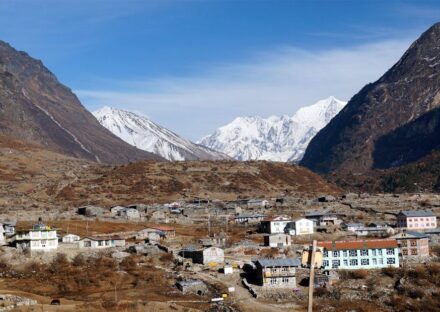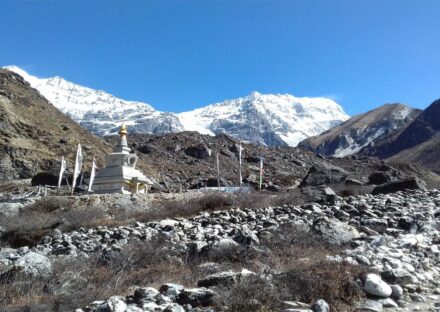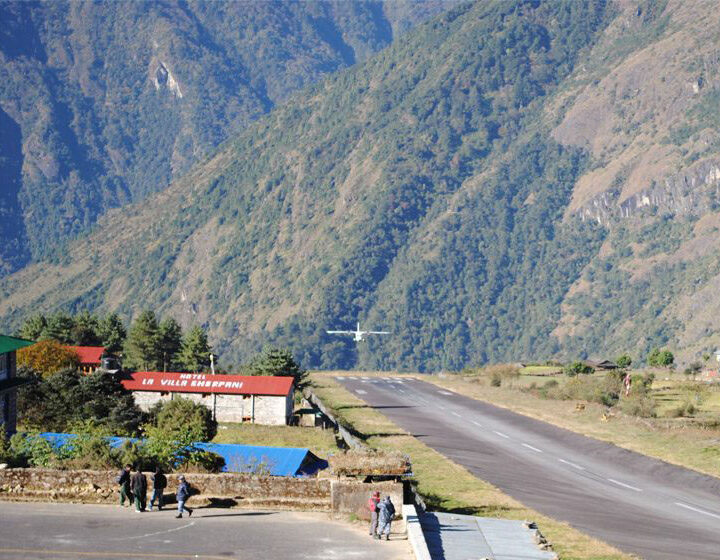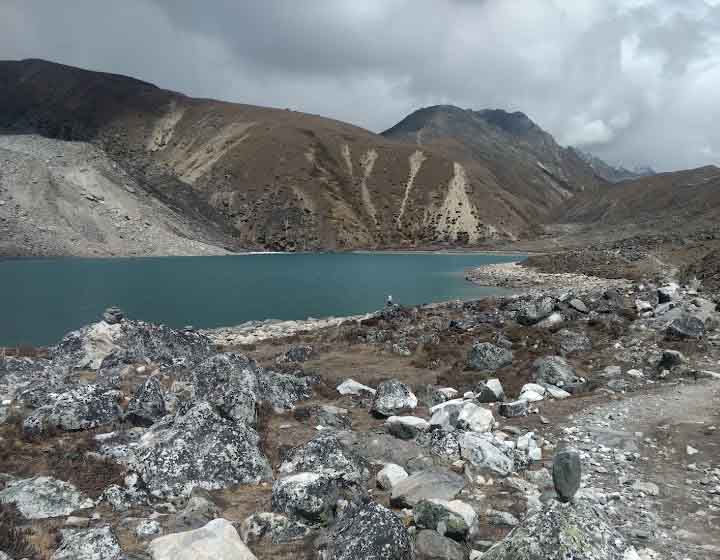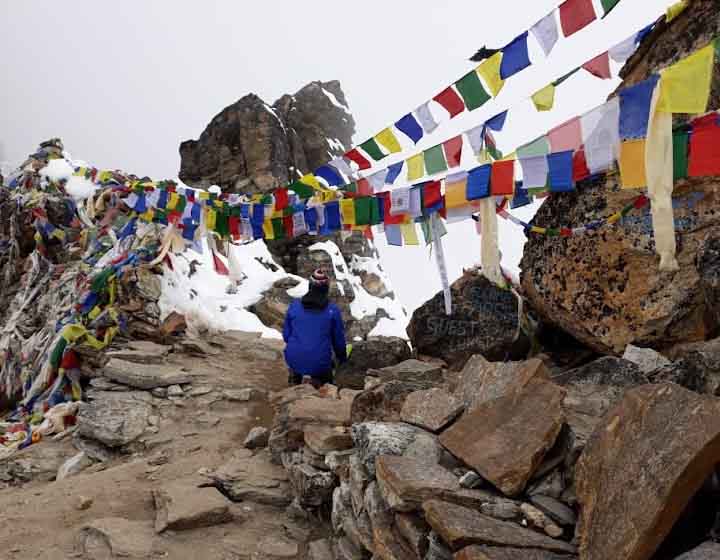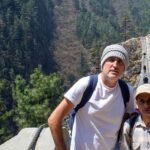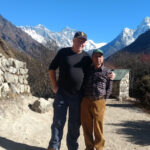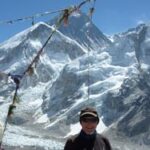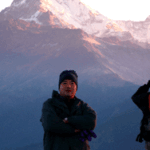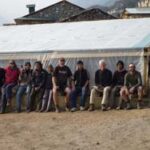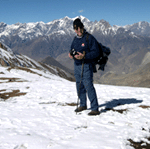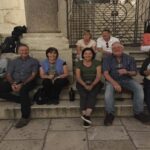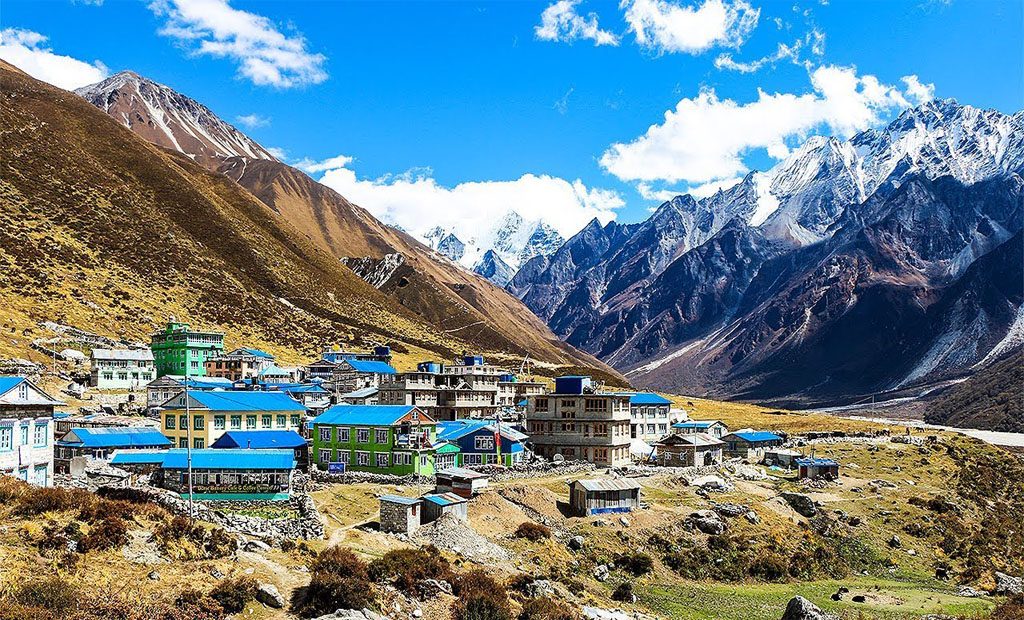
Trip overview
Overviews: Lang Tang 8-day trek
The Langtang Valley Trek is one of the most beautiful treks in Nepal. It is an accessible trekking destination in Nepal. It is located north of Kathmandu near the Tibetan border. As it is known as the “Valley of Glaciers. The Lang Tang Valley trek offers stunning landscapes. It is a rich cultural experience and has diverse flora and fauna.
The Langtang Valley is a beautiful trekking destination in Nepal, located north of Kathmandu, near the Tibetan border. The name “Langtang“ is believed to have originated from Tibetan words: Lang,“ meaning “an ox, and “Tang,” meaning flat land or valley. The Lang Tang valley is, according to legend, where a Buddhist lama (monk) was searching for his lost ox in the valley, and this led to the discovery of the region. there for the village named Langtang—the “Valley of the Lost Ox.”
The Lang Tang Valley trek is famous for its stunning landscapes, snow-capped mountains, glaciers, rich Tamang culture, and the Langtang National Park, which is home to diverse flora and fauna.
Duration: 7-10 days Maximum Elevation: 4,984m (Tserko Ri) Starting Point: Syabrubesi (1,503m) Best Seasons: Spring (March-May) & Autumn (September-November). Difficulty Level: Moderate. Accommodation: Teahouses/lodge. Permits Required: Langtang. National Park Entry Permit. TIMS (Trekkers’ Information Management System) Card.
Lifestyle & Culture:
The Langtang region is home to the Tamang and Tibetan communities, who have a rich cultural heritage influenced by Tibetan Buddhism. Their lifestyle revolves around yak herding, agriculture, and tourism. Visitors can witness ancient monasteries, traditional stone houses, and prayer flags fluttering along the trails.
Post-Earthquake Revival:
The Lang Tang valley is The area is recovering from the 2015 earthquake, with rebuilt teahouses and a resilient community, giving it an inspiring and hopeful atmosphere.
Cultural Highlights:
Vegetation & Wildlife: The trek passes through Langtang National Park, known for its diverse ecosystem. Vegetation Zones: Subtropical Forests (1,500m – 2,500m)—Rhododendron, oak, and bamboo forests Temperate Zone (2,500m – 3,500m) – Pine and fir trees. Alpine Meadows (3,500m – 5,000m) – Shrubs, juniper, and wildflowers. Glacial & Rocky Terrain (Above 5,000m) – Bare landscapes with snow and ice
Mammals:
Red Panda (Ailurus fulgens)—One of the most iconic and rare species in the Langtang region, often found in bamboo forests. Himalayan Tahr (Hemitragus jemlahicus)—A large wild goat species seen grazing on steep slopes. Snow Leopard (Panthera uncia)—A highly elusive predator, mainly found in higher elevations. Musk Deer (Moschus chrysogaster)—Known for its valuable musk pod, this species is often found in dense forests. Himalayan Black Bear (Ursus thibetanus)—Occasionally spotted in forested areas. Rhesus Macaque (Macaca mulatta) and Langurs (Semnopithecus schistaceus)—common monkey species in the lower- and mid-elevation forests.
Birds:
Himalayan Monal (Lophophorus impejanus)—Nepal’s national bird, known for its vibrant colors. Snow Partridge (Lerwa lerwa)—Found in high-altitude regions. Blood Pheasant (Ithaginis cruentus)—A striking bird often spotted in rhododendron forests. Yellow-billed Chough (Pyrrhocorax graculus) and Red-billed Chough (Pyrrhocorax pyrrhocorax)—Common in high-altitude areas. Himalayan Griffon Vulture (Gyps himalayensis)—A large scavenger bird that soars over the mountains.
Other Wildlife:
Himalayan Marmot—Found in alpine meadows and rocky areas. Pikas—small, rabbit-like creatures seen in rocky terrains. Various reptiles and amphibians—including lizards and frogs in lower elevations. The Langtang region’s rich biodiversity makes it an excellent destination for wildlife enthusiasts and trekkers interested in nature conservation. Red Panda, Himalayan Tahr, Snow Leopard (rarely seen) Musk deer, various bird species
Atmosphere & Weather:
The Langtang region has a cool and fresh mountain atmosphere, with significant variations in temperature depending on altitude and season.
Spring (March-May):-):
Warm days (10-20°C), rhododendrons in bloom
Summer/Monsoon (June-August): Humid, frequent rain, landslides possible Autumn (Sept-Nov): Clear skies, best trekking season (5-15°C) Winter (Dec-Feb): Snowfall, freezing temperatures (-10°C or lower at higher altitudes)
Highlight points:
Stunning Himalayan Views: Panoramic views of Langtang Lirung (7,227m), Ganesh Himal (7,422m), and Dorje Lakpa (6,966m). Clear sight of snow-capped peaks, glaciers, and alpine landscapes.
The Langtang National Park:
Home to red pandas, Himalayan thars, snow leopards, and musk deer, and plants are lush forests of rhododendron, oak, and bamboo, especially vibrant in spring.
Rich Tamang Culture:
Experience the Tamang and Tibetan Buddhist heritage in villages like Langtang, Kyanjin Gompa, and Syabrubesi. Visit ancient monasteries, mani walls, and chortens reflecting Tibetan influence.
Kyanjing Gompa (3,870m):
Kyanjin Gompa is a beautiful and culturally significant village in the Langtang Valley of Nepal, located at an altitude of about 3,870 meters (12,697 feet). It is one of the main highlights of the Langtang Valley Trek and serves as a base for trekkers exploring the surrounding peaks and glaciers. A significant Buddhist monastery with stunning mountain backdrops. Visit the yak cheese factory to taste fresh local cheese.
Trekking and Side Trips:
Kyanjin Ri (4,773m): A popular viewpoint offering panoramic views of the Langtang Himalayan range. Tserko Ri (5,000m): A challenging hike with spectacular sunrise and mountain views. Langshisha Kharka: A remote, beautiful pastureland with stunning landscapes Langtang Glacier offers a close-up experience of the Himalayas.
Glaciers and Rivers:
The trek follows the Langtang Khola (River), originating from glaciers. Witness the impressive Langtang Glacier near Kyanjin Gompa.
Less Crowded & Accessible Trek: –A great alternative to Everest and Annapurna regions, with fewer trekkers. It starts from Syabrubesi, just a 6–7 hour’ drive from Kathmandu.
Conclusion: Langtang Valley Trek—8 Days
The 8-day Langtang Valley Trek is the perfect blend of adventure, culture, and natural beauty, ideal for trekkers looking for a Himalayan experience in a short time. From exploring Tamang culture to enjoying breathtaking views of snow-capped peaks like Langtang Lirung, every moment of the trek offers a unique and rewarding encounter with the mountains. This trek not only brings you closer to nature but also supports the local communities who are still rebuilding after the 2015 earthquake. Whether you are a first-time trekker or a seasoned traveler, Langtang Valley promises memories to last a lifetime.
Short Itinerary
Day 1: Drive from Kathmandu to Syabrubesi (1,460 7-8 hrs
Day 2: Trek to Lama Hotel (2,470 m)—6 hrs
Day 3: Trek to Langtang Village (3,430 m)—6 hrs
Day 4: Trek to Kyanjin Gompa (3,870 m)—4 hrs
Day 5: Hike to Tserko Ri (4,984m) and back to Kyanjin Gompa—6 hrs
Day 6: Trek back to Lama Hotel—6-7 hrs
Day 7: Trek to Syabrubesi and drive to Kathmandu
Itinerary
Arrival in Kathmandu Tribhuban international airport (1,300m/4,264ft): then pick you up and take a short drive from the airport to the hotel check-in the hotel and rest for few hrs then we meet again with guide and barging about the trek what we need the equipment for then trek and what time we live from Kathmandu details.
Arrival in Kathmandu Tribhuban international airport (1,300m/4,264ft): then pick you up and take a short drive from the airport to the hotel check-in the hotel and rest for few hrs then we meet again with guide and barging about the trek what we need the equipment for then trek and what time we live from Kathmandu details.
After breakfast, we begin our trek to Syabrubesi along the Langtang Khola. We ascend and descend all together through oak and rhododendron forests. After crossing a bridge over the Langtang Khola (small river), we ascend on a steep trail which will lead us to the Lama Hotel. Stay overnight in Lama Hotel at tea house Lodge.
After breakfast, we continue ascending from Lama Hotel and enjoy the mountain landscape with plentiful waterfalls. As we reach the green meadows of Ghoda Tabela, we begin to see the white peaks of the Langtang range. Our trail continues to climb up the widening valley, passing a few temporary settlements used by herders. We pass a Buddhist monastery before reaching the Langtang village which was affected by the April 2015 earthquake. We continue on our trail to Mundu. Stay overnight in Mundu at tea house Lodge.
After breakfast, we will start our journey to Kyangjin Gompa, a most important monastery of the region. We pass by water mills, prayer wheels, chortens, with sacred mounds of rocks with inscriptions carved on them. We also pass by the largest mani wall in Nepal, made from stone with prayers written on them. After the short trek, we spend the rest of the afternoon exploring the Buddhist shrine in Kyangjin Gompa and surrounding areas with the remarkable views of the mountains. Stay overnight in Kyanjin Gumpa at tea house Lodge.
We spend the whole day exploring Tserko Ri which will also help us acclimatize to the high altitude. We begin early in the morning. The trail passes through yak pastures before ascending to Tserko Ri. The sunrise view from the top of Tserko Ri is amazing. We get back to Kyangjin Gompa by late afternoon and explore the beautiful monastery while enjoying views of the Himalayas. Stay overnight in Kyanjin Gumpa at same tea house Lodge.
After breakfast, we begin our trek and go back over our steps to Lama Hotel. Most of the trekking today will be downhill as we pass through forests and beautiful Tamang villages. We also get to enjoy a different view of the Himalayas that we had missed climbing up. Stay overnight in Lama Hotel at tea house Lodge.
We basically retrace our steps back to Syabrubesi. The trek will be easier as it will mostly involve descending. Stay overnight in Syabrubesi at tea house Lodge.
After breakfast, we drive back to Kathmandu from Syabrubeshi it will take 7-8 hrs. We spend the rest of the day packing and maybe catching up on some last-minute souvenir shopping. Stay overnight in Kathmandu at the Hotel.
From hotel to Tribhuvan international airport: – today is free or last minute you have few hour special shopping for your relatives. If you have more time you can do some shopping or sightseeing then We will drop you to the International airport to catch your flight back to your home and wish for your Safe journey.
Included
- 2 Night accommodation in Kathmandu with a B/B basis plan.
- Kathmandu to Syabrubeshi transfer by bus.
- All airport and hotel transfers
- National permit & TIMS permit ( Trekking Information Management System)
- Accommodation, food and tea/coffee during the trek
- Guide:- including salary, insurance, equipment, flight, food, and lodging
- Porter:- including salary, insurance, equipment, food, and lodging.
- Transfer from Syabrubeshi to Kathmandu by bus or private Jeep.
- For guest:-Down jacket, Good sleeping bag (down jacket and sleeping bag are to be returned after trip completion)
- All government and local taxes
Not Included
- Food in Kathmandu Lunch & Dinner)
- Bakery food during the trek. When you eat in the bakery that you need to pay by yourself
- Nepal Visa fee
- International airfare from your country to Kathmandu and from Kathmandu
- Extra night accommodation in Kathmandu
- Travel and rescue insurance if the guest gets mountain sickness and needs to rescue helicopter.
- Personal expenses example (phone calls, laundry service, bar bills, battery recharge, extra porters, bottle or boiled water, shower etc)
- Tips for guide and porters
- Sightseeing sport fees. tours guide cost and vechicle cost
- Sightseeing guide and vehicle
Join Us Upcoming Trips
Book this trip with us. Here are the upcoming dates. Feel free to share this trip with your friends and family. For custom trips or general inquiries contact us.
| Departure Date | Trip Duration | Price | Status | |
|---|---|---|---|---|
| 12 October, 0025 | 7 Days | $1250 | Fixed departure | |
| 12 October, 0025 | 7 Days | $1250 | Fixed departure | |
| 21 October, 2025 | 7 Days | $1250 | Fixed departure | |
| 05 December, 2025 | 7 Days | $1250 | Fixed departure |
Useful Info
Physical Fitness & Training: -Start cardio exercises (hiking, running, cycling) 4–6 weeks before the trek Strength training (leg workouts, core exercises) Practice long walks with a loaded backpack
Packing List: -Base layers (moisture-wicking shirts)
Fleece or down jacket for warmth
Waterproof & windproof jacket
Trekking pants & thermal innerwear
Gloves, hat, and sunglasses
Good quality trekking boots
Gear & Equipment: -Trekking poles (helpful for steep sections)
Sleeping bag (comfort up to -10°C) Daypack (20-30 )
Headlamp with extra batteries
Documents & Essentials: - Passport & permits
Insurance covering high-altitude trekking Cash (ATMs unavailable in trekking areas)
Health & Safety:
First-aid kit (medicines for altitude sickness, diarrhea, headache, etc.)
Hydration (carry a water purification system or tablets)
Travel insurance with emergency evacuation coverage
FAQs
-
How difficult is the Langtang Valley Trek?
The trek is considered moderate. It’s suitable for trekkers with a reasonable level of fitness. The trails involve some steep ascents, but no technical climbing is required.
-
What is the maximum altitude of the trek?
The highest point of the trek is Kyanjin Ri (4,773 meters / 15,655 feet). Trekkers also spend a night in Kyanjin Gompa (3,870 meters / 12,697 feet).
-
What is the best time to do the Langtang Valley Trek?
Spring (March to May) – Rhododendrons in full bloom and Autumn (September to November) – Clear skies and stunning mountain views
-
What kind of accommodation is available during the trek?
You’ll stay in teahouses/lodges, which offer basic but comfortable accommodation with meals. Rooms are typically twin-sharing with shared bathrooms.
-
What kind of food is available on the trek?
You’ll get a mix of Nepali, Tibetan, and continental dishes, including: Dal Bhat (lentils and rice) Noodles, pasta, soups Pancakes, eggs, porridge for breakfast
-
How do I get to the starting point of the trek?
The trek usually begins from Syabrubesi, which is about a 6–7 hour drive from Kathmandu by private jeep or public bus.
-
Is Wi-Fi available during the trek?
Some lodges offer Wi-Fi for a fee, but the connection can be slow or unreliable. Enjoy the natural escape!
